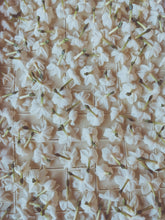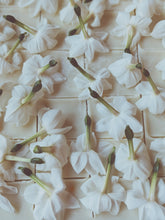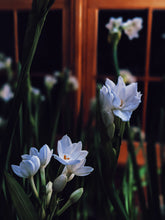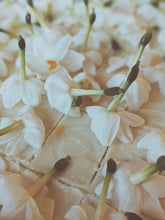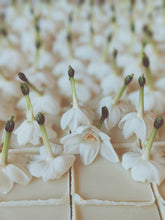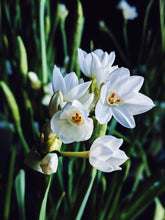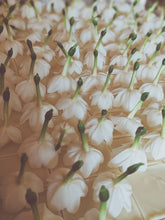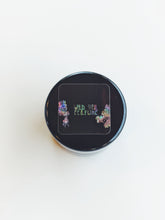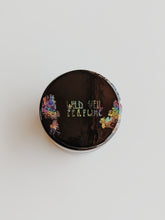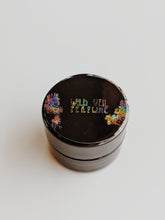
Limited edition Narcissus and Assam Agarwood Enfleurage
This is an organic, whole plant perfume made using the old method of cold enfleurage. My winter paperwhite narcissus charged on pommade I fixed with Assam agarwood. This Aquilaria malaccensis oil has a smoky, barnyard, cut grass profile, like a farm smokehouse in spring. Please note, this organic enfleurage is labor intensive and produces a subtle but complex aromatic extract: sweet and powdery, somewhere between lily and heliotrope, with a wet green, musky back note that is enhanced by the Indian agarwood. This scent is intimate and will warm to your skin. Do not expect it to have much projection: enfleurage is for the enjoyment of the wearer in connection with the original plants.
Literally, "in flower," enfleurage is an ancient method of extracting fragrance utilizing only fat and plant material. Deceivingly simple, it requires constant care, both of the plant and of your product, monitoring daily for new blooms, changes in scent, decomposition on the fat, and mold. In this enfleurage, I prepared an unscented base of mango, avocado and shea nilotica butters tempered with wild beeswax (all raw and organic). As the mixture cooled, I gently worked my agarwood extract in so as not to lose any precious woods top notes. Once hardened, I began the enfleurage process to capture the the winter bloom of green jonquil. This "pommade" (highly scented solid perfume-- not to be confused with pomade for hair!) consists of thousands of individual organic narcissus blossoms that I gathered from my perfume gardens, laid onto the fat. I repeated this process to reach a high degree of fragrance saturation. Each repetition is a "charge," and this enfleurage was charged the traditional 36 times. The aroma possesses the unmistakable indolic signature of white flowers, with narcissus's sunny marzipan heart notes. It is very much the opposite of the shrill, overpowering version of a synthetic floral you find at the fragrance counter. Only you and those closest to you will be able to smell it. Apply to pulse points.
Photos: fresh paperwhites charging the enfleurage pommade and my paperwhite narcissus in bloom; enfleurage in 5ml and 10ml black violet glass jars.
This is available in 1ml (a sample of approximately 20-25 drops), 5ml and 10ml. 1ml (sample size) comes in a hinge top pod. 5ml comes in a glass jar. 10ml is available in a glass jar or a round tin.
PLEASE READ:
**Although the floral perfume produced by enfleurage is osmically balanced (meaning it contains sufficiently complex interplay of top through base notes to be considered a perfume in itself), it is a subtle creation. It must be given time to breathe on the skin. When cold, it may not smell much at all. Allow it to breathe and warm on a pulse point before inhaling deeply. Most noses love the aroma of my enfleurage but, a small percent of my clients are anosmic to enfleurage and therefore cannot smell the floral fragrance. This has to do with natural differences in nasal receptors and is not due to an issue with the product. I always recommend ordering a sample before committing to a larger size for this reason.**
A B O U T • W I L D • V E I L • E N F L E U R A G E
Enfleurage is a beautiful process whereby odorless fats that are solid at room temperature are used to capture the fragrant compounds exuded by plants. Enfleurage is by far one of the oldest methods of fragrance extraction, and it is nearly extinct. Only a handful of artisans still practice it today as it is no longer used in the manufacture of perfumes on a mass scale. A voluptuous art, enfleurage is quite the labor of love, consuming time, labor, and expense. Historically enfleurage was done by women, or maidens, in the fields of Grasse, France. Although far rarer to find enfleurage products in the market today, is still "largely" practiced by women.
There are two types of enfleurage: "cold" and "hot." Wild Veil exclusively uses cold enfleurage:
In cold enfleurage, a large framed plate of glass, called a chassis, is smeared with a layer of fat, traditionally unscented animal fat rendered from lard or tallow, and allowed to set. Wild Veil does not use any animal fat whatsoever! My enfleurage products are organic and botanical; I purvey fats from a variety of nut and plant butters such as shea, jojoba, avocado, fair trade palm, and mango. Botanical matter, usually petals or whole flowers, is then placed on the fat and its scent is allowed to diffuse into the fat over the course of 1-3 days. The process is then repeated (up to 36 times depending on the fat and the botanical matter) by replacing the spent botanicals with fresh ones until the fat has reached a desired degree of fragrance saturation. The cold fat process was developed in southern France in the 18th century for the production of high-grade concentrates.
In hot enfleurage, solid fats are heated and botanical matter is stirred into the fat. Spent botanicals are repeatedly strained from the fat and replaced with fresh material until the fat is saturated with fragrance. This method is considered the oldest known procedure for preserving plant fragrance substances. So far Wild Veil only incorporates cold enfleurage into products.
In both instances, once the fat is saturated with fragrance, it is then called the "enfleurage pommade." This is a highly perfumed solid fat, not to be confused with pomade used for styling hair. Historically, this enfleurage pommade was either sold as it was,* or it could be further washed or soaked in ethyl alcohol to draw the fragrant molecules into the alcohol. When the alcohol was separated from the fat and allowed to evaporate, it would leave behind the absolute of the botanical matter. The spent fat would typically be used to make soaps since it is still fairly fragrant. *This listing is for an organic pommade.
The advent of modern perfumery ushered in the ease and relative inexpense of commercial solvent-based extraction of natural materials along with mass production of synthetic compounds, making the art of enfleurage seem highly inefficient and costly in comparison. The method is now superseded by more efficient techniques such as solvent extraction or supercritical fluid extraction using liquid carbon dioxide (CO2) or similar compressed gases. Enfleurage had been the sole method of extracting the fragrant compounds (containing thousands of aromachemicals) from delicate floral botanical such as jasmine and tuberose, which are be destroyed or denatured by the high temperatures required by cheaper methods of fragrance extraction such as steam distillation. It is still believed by some perfumers that enfleurage remains the only way to capture and preserve the full range of complexity of certain scents, particularly of flowers.
All aesthetic material copyright Abby Hinsman 2019.









